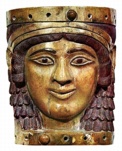ivory - Tusks
or teeth of mammals, especially those from elephants, walrus,
hippopotamus, and whale; or the smooth, hard, yellowish-white
material of which they
consist; or a thing made of ivory.
May also refer to the color of ivory, a pale grayish yellow to yellowish white. Because so many tusk producing animals are endangered species, it is unethical to purchase, use, or sell contemporary ivory. There are synthetic materials which appear nearly identical to ivory.
Examples of works in ivory (in the first sense above):

Central Anatolia, Furniture support: female sphinx with Hathor-style
curls, 18th century BCE,
Old Assyrian period Acemhöyük (probably), ivory, gold foil, height
5 inches (12.7 cm), Metropolitan Museum of Art, NY.

Egypt, Prancing Horse, c. 1391-1353 BCE,
late Dynasty 18, probably reign of Amenhotep IV, New Kingdom,
stained ivory, garnet inlay,
length 6 inches (15 cm),
Metropolitan Museum of Art, NY. See Egyptian art.

Mesopotamia, Nimrud, Head of a Woman, late 8th century BCE, ivory plaque, originally part of furniture. This is one of many Mesopotamian objects that have recently been lost or stolen from Iraq's museums, and have yet to be recovered. The Oriental Institute of the U of Chicago has posted a database of treasures that have been lost or stolen from Iraq.

Parthia, Rhyton, 2nd-1st centuries BCE,
ivory, Hermitage Museum, St. Petersburg, Russia. See rhyton.

India, Orissa, Seated Ganesha, 14th-15th century, ivory, height
7 1/4 inches (18.4 cm), width
4 3/4 inches (12.1 cm), Metropolitan Museum of Art, NY. See Ganesha and Hindu art.

Nigeria, Edo peoples, Court of Benin, Pendant Mask: Iyoba, 16th century, ivory,
iron, copper,
height 9 3/8 inches (23.8
cm), Metropolitan Museum of Art, NY. See African art, mask, and pendant.

Henry Benbridge (American, 1743-1812), Portrait of a Gentleman, c. 1770, miniature watercolor
on ivory, 1 1/4 x 1 7/8 inches (3.2 cm. x 4.8 cm), Metropolitan
Museum of Art, NY.

Tonga, Ha'apai Archipelago, Tongan people,
Female Figure, early 19th century, whale
ivory, height 5 1/4 inches
(13.3 cm), Metropolitan Museum of Art, NY.

Shokyusai Tomoyuki (Japanese), Netsuke Showing the Shaving of a Demon in the
Guise of a Monk, second half of the 19th century, ivory, 4.6 x 2.9 cm, Edo
School, Hermitage Museum, St. Petersburg, Russia. See netsuke.
May also refer to the color of ivory, a pale grayish yellow to yellowish white. Because so many tusk producing animals are endangered species, it is inappropriate to purchase, use, or sell contemporary ivory. There are synthetic materials which appear nearly identical to ivory.
Also see Ada school, blanc de Chine, encaustic, and statue.
https://inform.quest/_art